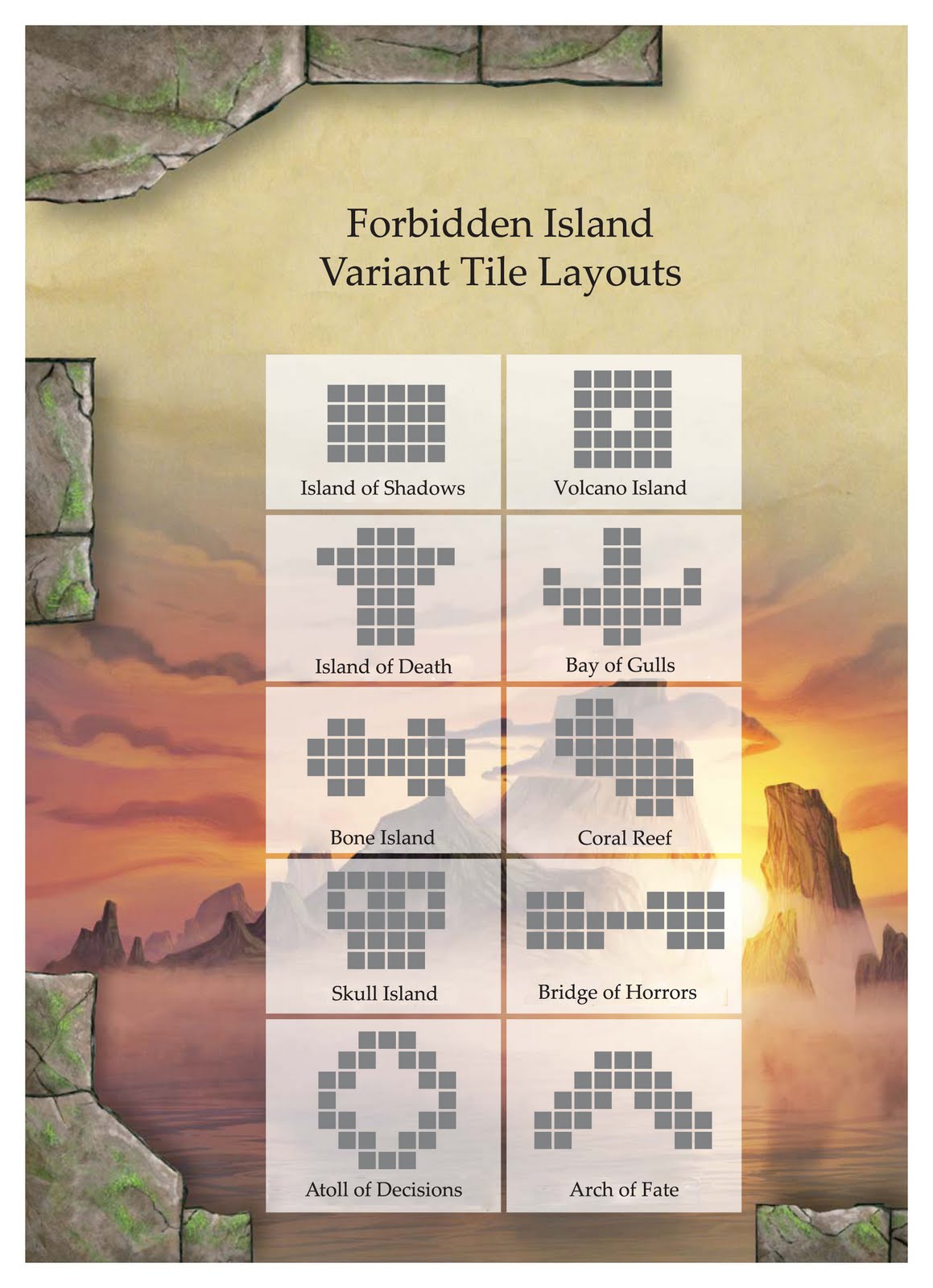'Forbidden Island' game variants
Charles Roth, 14 Dec 2014
(Techblog top)
Updated 23 May 2021
 I. Introduction
I. Introduction
Forbidden Island
is a lovely multi-player "cooperative" game in which the
players work together to remove mystic treasures from an ancient island before it sinks
beneath the waves.
I highly recommend it, especially for people who want a not-too-complicated
or not-too-competitive
game to play with friends.
Once you've mastered the basic game though, there are several ways to make it
more interesting...
II. Alternate island layouts
There's a very interesting discussion at
boardgamegeek.com/thread/569926/official-variant-tile-layouts
about different ways of arranging the tiles,
to make the game more challenging, or at least force players
to come up with different strategies.
The 'best' set is shown at the right (click on it to expand to full size),
although there are many others.
(I'm particularly fond of the "Bridge of Horrors".)
When using the alternate layouts, you may find it useful to 'mark'
sunken tiles, so that you know which spaces are passable by the diver
(and which are not).
(Some folks consider the central space in 'Volcano Island' to be lava,
and not passable by anyone.)
III. Magic Treasures
The fundamental premise of the game is that trying to remove the 'magic'
treasures (figurines) triggers the sinking of the island.
So why not add some 'magic' to the treasures?
Here are additional rules that I have proposed.
They add strategic options, especially in the face of the more
difficult layouts (e.g. the Bridge of Horrors).
Each treasure has a specific ability.
If you (an individual player) have a treasure,
you can use its power -- once -- by invoking it as an action.
- Earth.
Select a tile (you need not be on it).
It must be dry or flooded (not sunken).
Invoking the Earth treasure prevents this tile
from ever sinking.
The card stays in the deck or the discard pile; the tile simply doesn't move
if its card is drawn.
(Clearly, Fool's Landing is a good choice; but there may be others.)
- Water.
This treasure immediately lowers the current water level by one.
- Fire.
This treasure reroutes magma underneath the island in such a way
as to raise a sunken tile all the way up.
Like Earth, the holder of the treasure selects the tile.
Note that the tile may sink again later in the normal way.
This means, for example, that even if Fool's Landing
sinks, as long as someone can get the fire treasure, the
game is not (yet) over.
It also means that you'll need a way to remember which sunken
tiles were where.
(We place the card under the tile, and then place a blue paper square over the tile.)
- Air.
This treasure creates a strong wind that opens a path
thru the water over sunken tiles (think Moses and the parting of the Red Sea).
All sunken tiles are passable in the normal manner by anyone, through to the end
of the treasure-holding player's next turn.
IV. Rule Clarifications
We've found that we needed some clarifications on a few rules.
Here are our interpretations/suggestions:
- Navigator/Explorer.
The Navigator may move the explorer diagonally.
(The rationalization is that, to the explorer, diagonal tiles are adjacent tiles.)
- Navigator/Diver.
The Navigator may not use the Diver's ability to swim thru multiple tiles.
The movement must still be 2 adjacent tiles.
However, the Diver can be "left" in the water over a sunken tile, to resume his/her swimming
on the Diver's turn.
 I. Introduction
I. Introduction